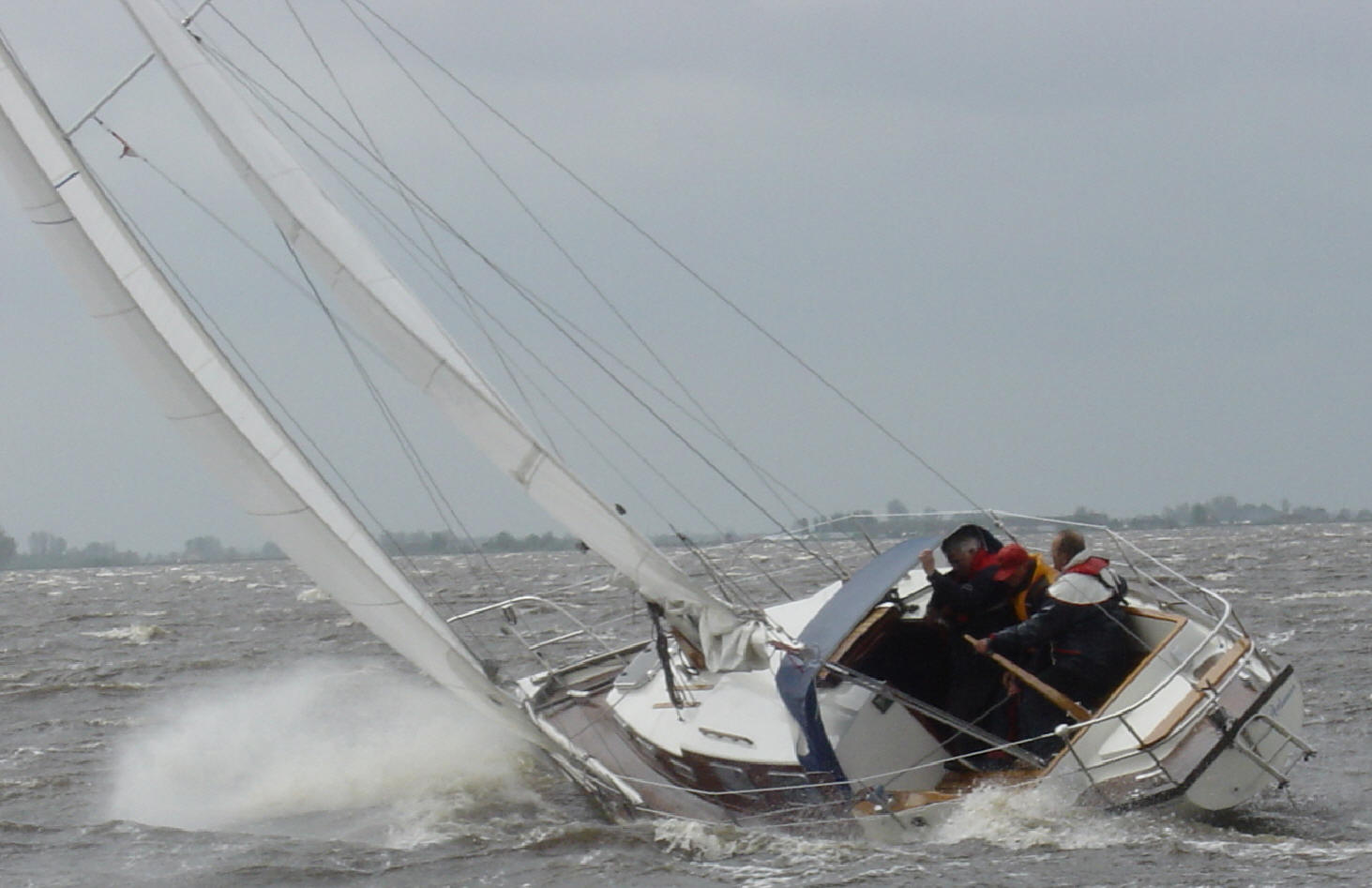General
The original moulds were owned by Tyler Boats (Kent, England) who produced a total of twelve Seacracker's. These moulds were then sold to their Tufglas division although it is understood that few, if any, were then produced. Production ceased when the moulds caught fire in 1978 at the Tyler factory in Kent.
Tyler Boat Co. Limited
Edward (Eddie) Tyler bought Cooya, a topsail gaff yawl, just prior to the First World War. She was first registered as a British Ship, No 137336, on June 23, 1914. By 1946, he was a successful builder and had begun using fibreglass to make moulds for concrete panels for prefabricated houses. One thing lead to another and he decided this material would be excellent for waterproofing boat decks - especially as his Cooya was now aging somewhat. After proving his theory, Edward Tyler later founded the Tyler Boat Company, building the first ever fibreglass production yacht, Glass Slipper, again to a Van de Stadt design.
After 1978, Tyler Boats never re-started as boat builders. With their roots in construction they refocused on an industrial property management company called Tyler Holdings. Despite the long gap, and despite the fact that they have no connection with boats now, Michael Vanns of Tyler Holdings has have been very helpful in filling in some gaps about the history of our boats.
They have a couple of old record books which show that a Seacracker was ordered by a Mr. Robinson in October 1973 and was assigned the production number S33/P12 - and their records show this as being the last of this type before the moulds were transferred to the Tufglas division in 1974. S33/P12 was delivered sometime in early 1974. (my thanks to Mr. Roger Saunders for this research).
It is worth noting that Tyler Boats continued to sell moulds as "Seacracker's" even after the Tufglas division started.
Incidentally, for those who are interested, the last known address for The Tyler Boat Co. Limited was:
The Shipyard Vicarage Lane
Hoo, Rochester, Kent, ME3 9LB
Tel: 01634 252709
Fax: 01634 255366
History of the Design
The Seacracker 33 is similar in design to the Harmony and is precisely the same hull as the Trintella IIA. This is contrary to some arguments but the fact is the Trintella IIA differs a bit from the IIB as the latter has a long keel with the rudder blade attached to the back end of the keel. Also, the IIb is shorter than the IIa (9.48 meters vs. 10.00 meters).
The story is that Van de Stadt first designed the Trintella II, but when it was built, they found out that it had too much weather helm. Therefore, in 1965, Van de Stadt shortened the keel, lengthened the back end of the boat and drew a rudder, with a small balancing part, on a skeg. This was the Trintella IIa and the Seacracker 33. These designs were made during the change in the racing rules from the old RORC to the new IOR system, so Van de Stadt chose to play safe and designed a sea-kindly, fast hull with fin and skeg. The Harmony 32 was also built by Tyler Boats.
Cruiser/racer
The intent of Van de Stadt seemed to be to provide fine performance without sacrificing comfort. All but one Seacracker has fibreglass decks vs. teak cladding which minimizes weight aloft and also to help maintain watertight integrity. Hull integrity is further enhanced through the use of a deck stepped mast which is supported by a substantial compression post resting on the keel

|
The photo to the left shows Seacracker 33 Sergeant Pepper hauled out of the water. You can see the resemblance to the Contessa 32 design. Slightly shallower draft @ 1.42m and just one foot longer in the LOA. The lines rise gently to the bow so offering a rather rakish look and a fine shape when beating to windward.
The typical Seacracker owner wants to sail fast in safety, and the majority of these boats have conservative rigs and their owners have eschewed adjustable backstays and severely raked masts. |
|
With her 1960's design, the Seacracker 33 can't match the accommodation of today's high volume cruisers and nor can they match the speed of the modern racing boats with their flat underwater profiles, narrow keels and tall rigs. However, the sea-keeping qualities of a Seacracker make them ideal for serious coastal cruising or offshore passage making.
When going to windward the Seacracker 33 excels. She will keep going, driving to windward, when the more modern cruisers are heaving to or heading for home, beating a Moody 42 in an F6/F7. The Seacracker will point higher and will sail faster. In other conditions, a Trapper 28 - which is a fast, light, racing boat with a minimal interior - is good competition but a Seacracker always seems to win until the kites go up!
Their performance under sail sees them easily clocking seven knots in less than 15 knots of wind. Unlike modern cruisers which have a vagueness on the helm, the Seacracker settles into a groove taking larger waves with a gentle parting, as opposed to bouncing over their tops. Under power, with a 20 HP 3 cylinder Volvo 2020 diesel engine, a cruising speed of 6.5 knots is comfortably achieved when using a correctly chosen three bladed propeller. |
|
Windward ability is superb, with careful trim achieving angles of 28 degrees off the wind. A typical sail configuration might include a 155% roller-reefing Genoa and a main stitched for three reefing points.
She carries a little weather helm and with almost half of her weight in the keel (2 Tons of encapsulated lead) she stiffens up in a breeze at around 15 degrees of heel. |

|
The rudder is hung on a skeg. The LOA is 10.00m and the LWL is 7.32m.
Versatility & Comfort
With the draft at four feet eight inches, the Seacracker is suitable for sailing into less well frequented anchorages and yet the keel is heavy enough to make a kind motion in poorer conditions. The most remarkable motion is noticed when encountering a steep swell (such as in the Bristol Channel, UK) when the hull simply parts the waves and the crew stays comfortable.
All the Seacrackers seem to have a different interior based on the owner’s preferences.
The forepeak provides ample accommodation for two (tall) crew in a 33' yacht, although the headroom does suffer somewhat from the anchor locker which drops down at the peak. The salon has one double berth to port and a single berth to starboard in some configurations others just have two settee berths. An excellent Pilot berth aft of the navigation station is comfortable and well sheltered and seems to be in most boats.
One of the more pleasant aspects of the Seacracker is her raised coach roof aft of the mast. This offers 6' 2" standing headroom throughout the critical part of the interior and permitted installation two larger than average windows to give these boats a light and airy feel although again the configuration opf the windows varies from boat to boat
The Seacracker 33 has a bullet-proof rig inspired by the IOR rule so, consequently, she derives most of her power from her Genoa. This can be a distinct advantage in heavy weather when sailing under jib alone she is able to maintain speed but makes for hard work short tacking up a river or dodging the tide inshore.
The large mast cross section carries a single pair of spreaders with no aft rake to them. The mast is stayed with fore and aft lower shrouds, and athwartships cap shrouds. In this fashion the baby stay so often found on modern cruiser-racers is eliminated, making spinnaker pole handling a much easier affair. The running rigging varies depending on the preferences of the owners. Travellers are located in different places, some have all control lines led aft others do not.
All in all these are strong seaworthy yachts capable of ocean crossings but with limited accommodation by modern standards.












